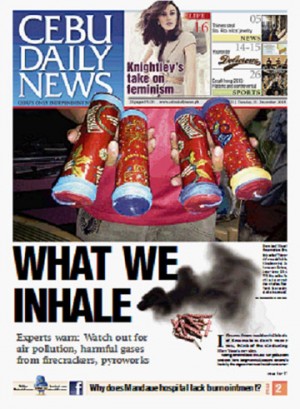
Using firecrackers causes air pollution and can have long-term ill effects on one’s health, the departments of health and environment warn every year.
After a night of firing up Judas Belt firecrackers and other pyrotechnics, parts of Metro Cebu turn smoky like a battlefield.
Some families who can afford to get away spend New Year’s eve in the towns, away from the city to avoid breathing air full of chemical fumes that can aggravate an asthma or heart condition.
Appeals to go easy or eliminate the use of firecrackers that pollute the air are repeated every Christmas and New Year’s celebration.
Environment advocates urge the use of alternate noise-makers like blowing horns, shouting cheers, banging drums and pots, switching on the stereo, or looping an audio recording of pyrotechnics blasts.
GASES
Firecrackers and other pyrotechnic materials contain sulfur, charcoal and other ingredients that when ignited, react with oxidants in the air to form carbon dioxide, carbon monoxide and nitrogen dioxide that are known greenhouse gases, said the Department of Environment and Natural Resources (DENR).
These also increase the number of coarse particulates or pollutants that can complicate respiratory problems, he added.
Cold weather and cloudy skies over the country can trap the pollutants near the ground for a longer period.
People with respiratory or pulmonary problems such as asthma and pneumonia can also expect their conditions to worsen when they breathe in the dirty air.
Burning tires produces black oily smoke containing carbon monoxide and other poisonous metals such as zinc that are harmful to humans when inhaled.
PICCOLO PHOSPHORUS
One popular illegal firecracker, the “piccolo”, contains phosphorus, trinitrotoluene (TNT), potassium nitrate and potassium chlorate, all of which are harmful chemicals, said Dr. Franklin Diza of the DOH central office’s Violence and Injury Prevention Program.
If ingested or inhaled, phosphorus, one of the ingredients of firecrackers, has long-term ill effects on a person’s liver, he said.
The toxic dose for phosphorus, he explained, is at least 0.3 milligrams per kilogram body weight. A fatal dose is 50 milligrams or more.
This means a child weighing seven kilograms who ingests 0.3 milligrams of phosphorus, if not treated immediately, is likely to suffer from liver-related ailments in the future, he said.
Not all people who get injured by firecrackers or accidentally ingested firecracker ingredients bother to go to the hospital at all.
He said that if it were up to the DOH, there should be a total ban on firecrackers, but he said the firecrackers are only tolerated because they are already part of the country’s culture.
NO SAFE FIRECRACKERS
“There are no safe firecrackers. Even if we have laws that regulate the manufacture of firecrackers, most of the injuries that have recorded came from the legal firecrackers,” Diza said.
He said the government has no detailed product standards for the makeup of firecrackers.
He explained that Republic Act No. 7183, which governs the manufacture, distribution and use of firecrackers, only states that every firecracker should contain not more than one-third teaspoon of gunpowder.
All the other components, such as chemical extenders or expanders, or even the ingredients that only serve to give weight to the firecracker, are not regulated by any standard.
These “other ingredients” are exposed to microbes and can easily infect injured people tetanus and other diseases, he said. /CDN RESEARCH

